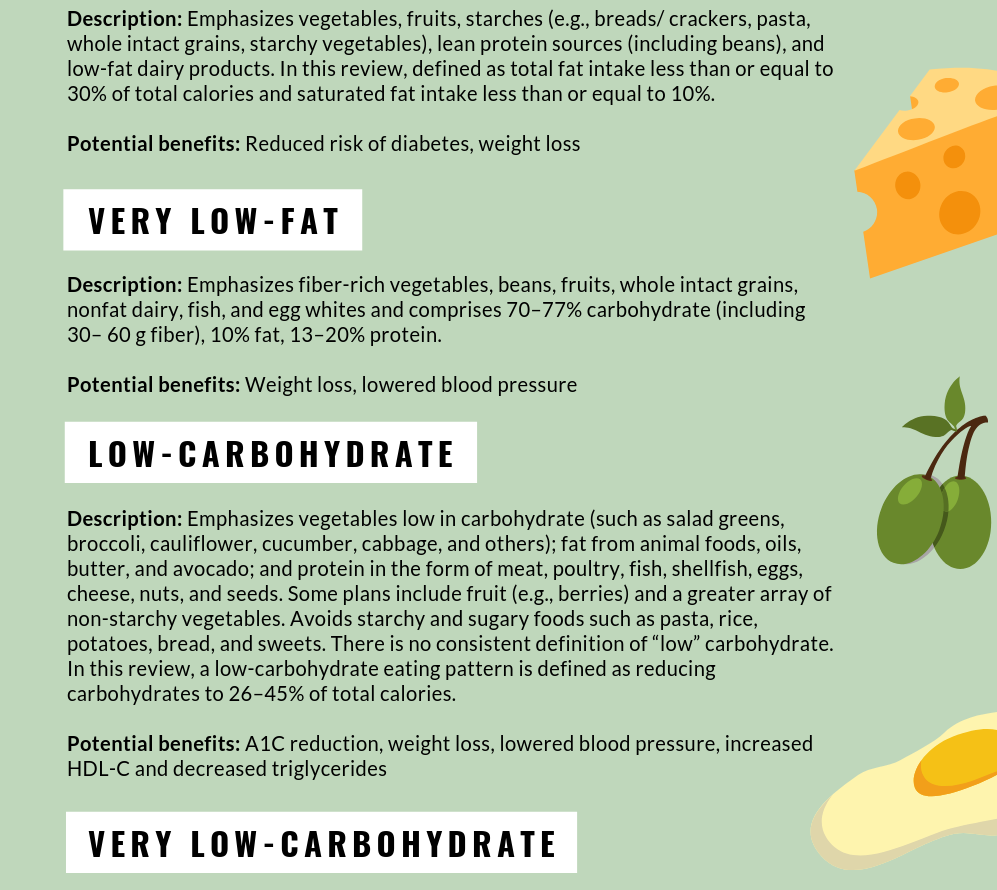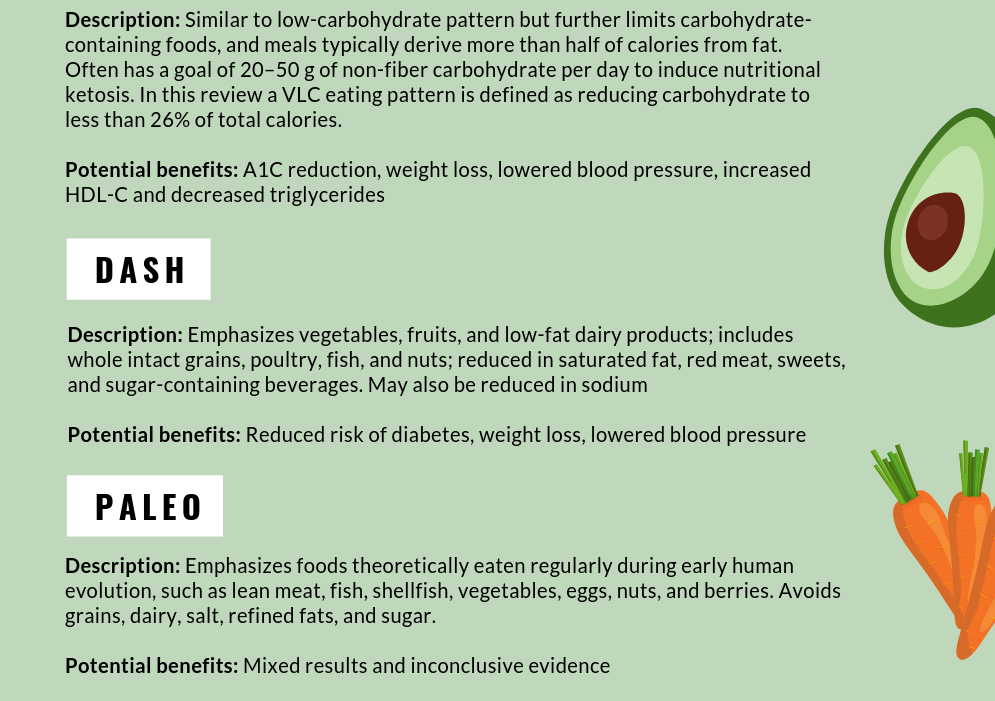What to Eat with Diabetes or Prediabetes: ADA's New Nutrition Guidelines
By Jimmy McDermottAdam Brown

By Jimmy McDermott and Adam Brown
More positivity around low-carb diets; importance of weight loss for type 2 diabetes and prediabetes; emphasis on eating non-starchy vegetables and minimizing sugar and refined grains; no one-size-fits-all approach
If you'd like to get articles like this delivered to your inbox, subscribe to our newsletter.
The American Diabetes Association (ADA) just released a nutrition consensus report with eating recommendations to help manage and prevent diabetes, and also to prevent complications such as heart disease. The report is based on research up through February 2018 – and marks the first update since 2014. The audience is healthcare professionals, though this document can be a useful read for all people who are interested in improving their diet and learning about the evidence.
The main takeaways:
-
There is much more positivity from the ADA for reducing carbohydrates – a major change from past updates, given growing evidence that low-carb approaches can improve blood sugars, reduce medication, and improve cardiovascular risk.
-
Weight loss is a major priority in the context of diabetes and nutrition, with goals set at 5% weight loss in type 2 diabetes and 7%-10% weight loss to prevent diabetes. The report also notes that over 50% of people with type 1 are not at their ideal weight.
-
The most emphasized nutrition advice for everyone is: increase vegetables, reduce sugars and refined grains, and choose whole foods over processed foods. Specifically, the advice says to increase “non-starchy” vegetables, which include salad greens, broccoli, cauliflower and more listed here!
-
There is no “one-size-fits-all” answer to diet and diabetes – see the chart below for several approaches, depending on your preferences and health goals.
Dr. Will Cefalu, Chief Scientific, Medical, and Mission Officer at ADA, emphasized in a conversation with us, “The Consensus Report is incredibly comprehensive, reflects the latest scientific evidence, and provides the most up-to-date nutritional guidance.”
Alison Evert, an author on the Consensus Report from University of Washington, added, “The consensus report committee was chosen after a national call of experts to ensure diversity. When the consensus report was convened, the committee members included not only experts in the field, but also a person living with diabetes who served as a patient advocate.”
You can read the report here. You might be also interested in seeing diaTribe’s nutrition guidelines, which are also science-based and in line with this ADA report. We encourage you to speak with your healthcare provider about a diet that is best for your treatment plan and priorities.
For more details on the main takeaways, continue reading below!
More openness for low-carbohydrate eating patterns
The ADA has much more enthusiasm for low-carbohydrate and very-low-carbohydrate eating patterns, in contrast to the recommendations published in 2014. The main points are:
-
Reducing overall carbohydrate intake for people with diabetes has “the most evidence” for improving blood sugars. A reduction in carbohydrates may be applied in a variety of eating patterns that meet individual needs and preferences.
-
It’s viable for select adults with type 2 diabetes to have low or very low carbohydrate eating plans, particularly if they are not meeting A1C targets or they are prioritizing reducing glucose lowering medications.
-
Low-carbohydrate diets can improve cardiovascular risk factors, including HDL, triglycerides, and blood pressure.
If you are looking for low-carbohydrate recipes, our article sharing low-cost, low-carb recipes by Catherine Newman is one of our top diaTribe articles of all time!
Recommendations on weight loss
ADA’s report emphasizes that weight loss is important for improving blood glucose, preventing diabetes, reducing heart disease, and even potentially achieving remission of type 2 diabetes. The report also noted that obesity prevalence has been increasing among people with type 1 diabetes, with over 50% of people with type 1 diabetes not at their ideal weight.
The benefits of weight loss, if needed, are so important that ADA says that any kind of weight loss diet that can be sustained and maintained is ideal for people with type 1, type 2, or prediabetes. More broadly, the consensus report recommends:
-
For people with type 2 diabetes, if needed, losing 5% of body weight to see a meaningful benefit. The ADA states that the goal for optimal benefit is weight loss of 15% or more, assuming it can be feasibly and safely accomplished.
-
For people with prediabetes, the goal is to lose 7%-10% of body weight for preventing progression to type 2 diabetes.
-
Focusing on controlling portion sizes in addition to eating patterns.
-
Aiming for a ‘collaborative effort’ between healthcare providers and people with diabetes to reduce weight.
-
Combining weight loss programs with more physical activity.
The latest research shows that some people with type 2 diabetes can even put their diabetes into remission with enough weight loss or by following low-carbohydrate diets. See our recent article on this important finding.
There is also a short section on intermittent fasting, an area with growing research and interest and some positive early data in diabetes and prediabetes. We expect this section will receive big updates over the next few years. We’ll be reporting on it too.
Key factors that are common among all of the diet options
At the bottom of this article, you will find the eating patterns reviewed in the report, and the potential benefits of each. Although there are many options, the recommendations suggest that nutrition choices should be focused on three things they all have in common:
-
Emphasize non-starchy vegetables – e.g., spinach, salad greens, cauliflower, broccoli, Brussels sprouts, asparagus, tomatoes, celery, zucchini, and more listed here (common starchy vegetables to avoid are corn and potatoes).
-
Minimize added sugars and refined grains – e.g., soda, juice, white bread, white rice, pasta, white flour, and more.
-
Choose whole foods over highly processed foods – e.g., single-ingredient food items rather than those with many ingredients.
Kelly Rawlings, an advocate for people with diabetes and author on the Consensus Report from Vida Health, stated that, “This new report says that many eating patterns can help you manage diabetes, and that your health status, any risk factors for diabetes-related complications, and your preferences are key. Consider pausing to ask yourself: Does this food or drink choice I’m about to make support my health goals?”
Emphasis on no one-size-fits-all eating plan for people with diabetes
For those wishing to hear one nutrition answer, there still isn’t one. Mediterranean, low carb, vegan/vegetarian, and many other dietary options have been shown to lower A1C, decrease weight, and reduce the risk of heart complications. Rather, it is weight loss, minimizing blood glucose excursions, reducing medication, and improving heart health metrics (HDL, triglycerides, blood pressure) that are key factors in helping to choose a diet.
Another section in the report provides recommendations on fat intake for people who are at risk for or have heart disease, as it can often be difficult to decide what type of fat to eat. The report states that, generally, replacing saturated fat (butter, cheese, milk, animal fats, cream) with unsaturated fat (olive oil, nuts, seeds, avocado, fatty fish) lowers cholesterol and may reduce the risk for heart disease. This is still controversial in the nutrition community, since longer studies are truly lacking.
Janice MacLeod, an author on the consensus report from Companion Medical noted, “A ‘one-size-fits-all’ approach just does not fit. This is not surprising considering the broad spectrum of people with diabetes, their cultural backgrounds, personal preferences, co-occurring conditions, and socioeconomic settings.”
We salute ADA for developing this Consensus Report and detailing the latest science and ADA recommendations in nutrition therapy for adults with diabetes. Read the report here. We hope to see more studies comparing different eating approaches head-to-head – ideally including time-in-range measurements.
.png)


This infographic was adapted from the American Diabetes Association Consensus Report on Nutrition Therapy for Adults with Diabetes or Prediabetes.







